MATTERS OF OBSESSION
‘The Love Revolution’: Artist Beezy Bailey illuminates the world of duality
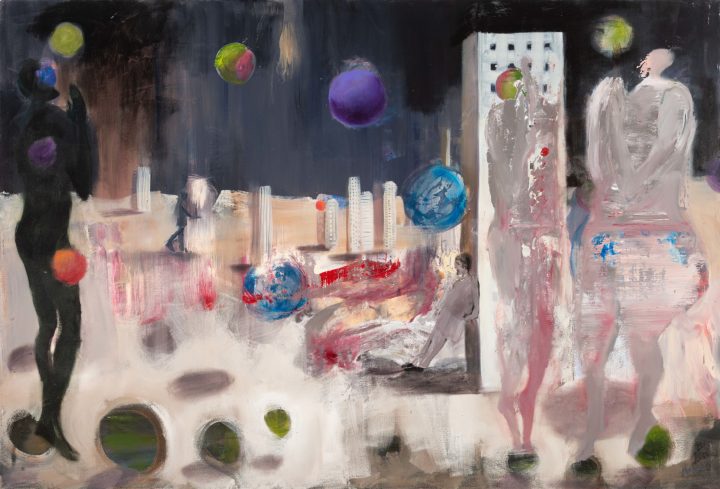
Bailey’s exhibition at the Everard Read CIRCA Gallery exalts the fullness of life in all of its glory (and despair).
“The world is made up of dark and light, there are equal degrees of each. You can’t see darkness without light. You can’t see lightness without dark,” said Beezy Bailey about his exhibition at the Everard Read gallery in Cape Town’s V&A Waterfront.
Most of us are familiar with the iconic yin-yang symbol: two halves of a circle, one black and one white, curving into each other. The concept behind the symbol, a fundamental piece of Chinese philosophy (though perhaps somewhat tastelessly appropriated and clichéd in Western culture) is that of balance and wholeness.
According to the World History Encyclopedia, the idea is that “all things exist as inseparable and contradictory opposites” and each side has, at its core, an element of the other (hence the inseparability.) There is no hierarchy between the light and the dark sides of the symbol; they are each equally important parts of the whole, and if a good balance can be struck between the two sides, ultimate harmony is achieved.
“The ever-changing relationship between the two poles is responsible for the constant flux of the universe and life in general. When there is too great an imbalance between Yin and Yang, catastrophes can occur, such as floods, droughts, and plagues.”
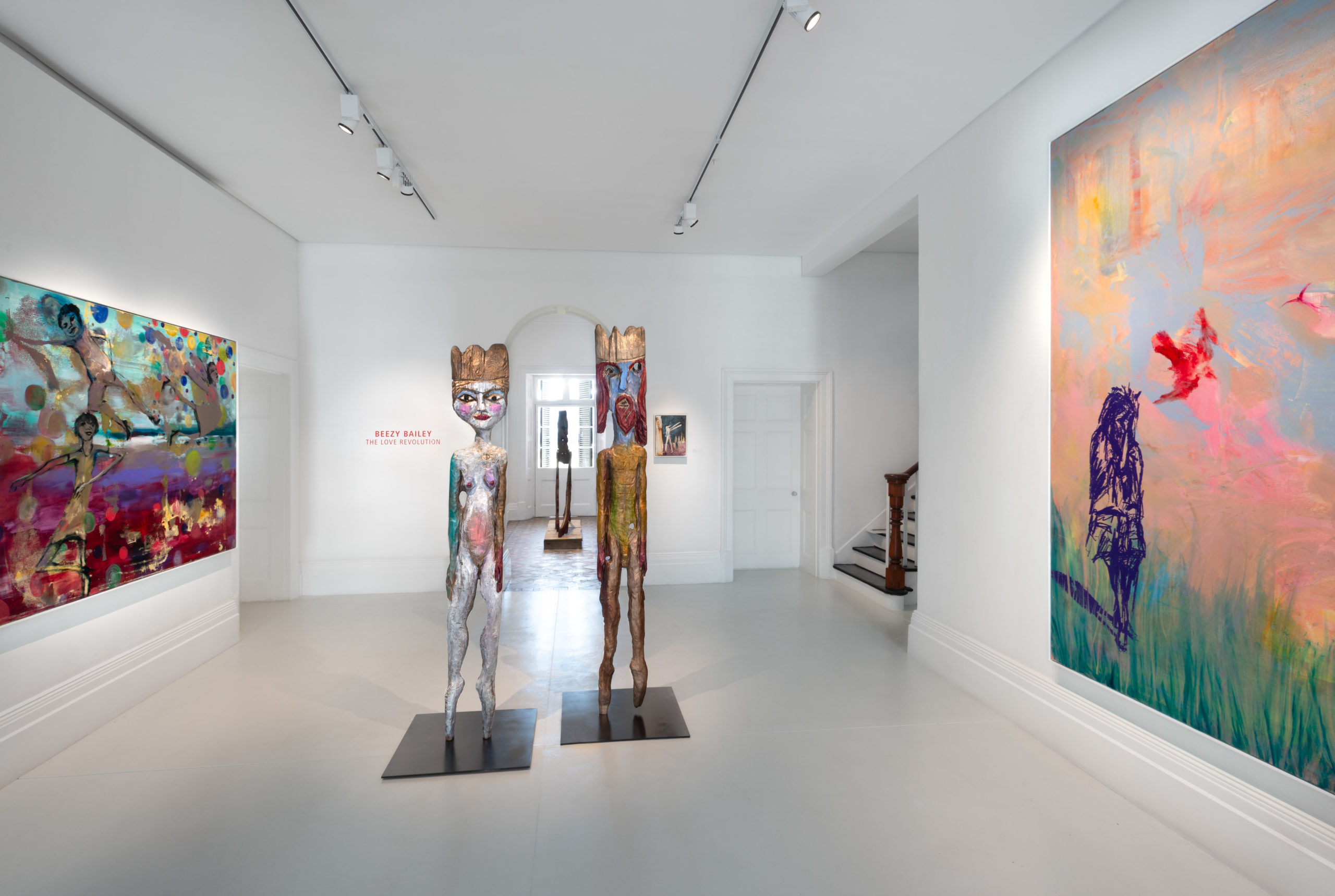
‘The Love Revolution’ – hand-painted bronzes by Beezy Bailey (Photo by Michael Hall; courtesy Everard Read CIRCA Gallery Cape Town)
Bailey’s The Love Revolution embodies the duality of life that the Yin and Yang symbol represents. It acknowledges the integral nature of light/darkness, love/loss, pain/pleasure, beauty/ugliness, etc while simultaneously questioning the thin line that society has drawn between these binary opposites.
Bailey confronts our preconceptions almost as soon as we walk through the gallery door, with a painting titled Falling off the World, hung at the very front of the gallery. In it, the world, a glowing, warmly coloured sphere, is cut in half by the top edge of the canvas. Bright orange nasturtiums and tiny faded gray figures that suggest bodies in various stages of falling, float from the world towards the bottom edge of the painting.
Who’s to say in which direction we would float? Are the stars above us, or we them? Is there even a top/bottom/left/right?
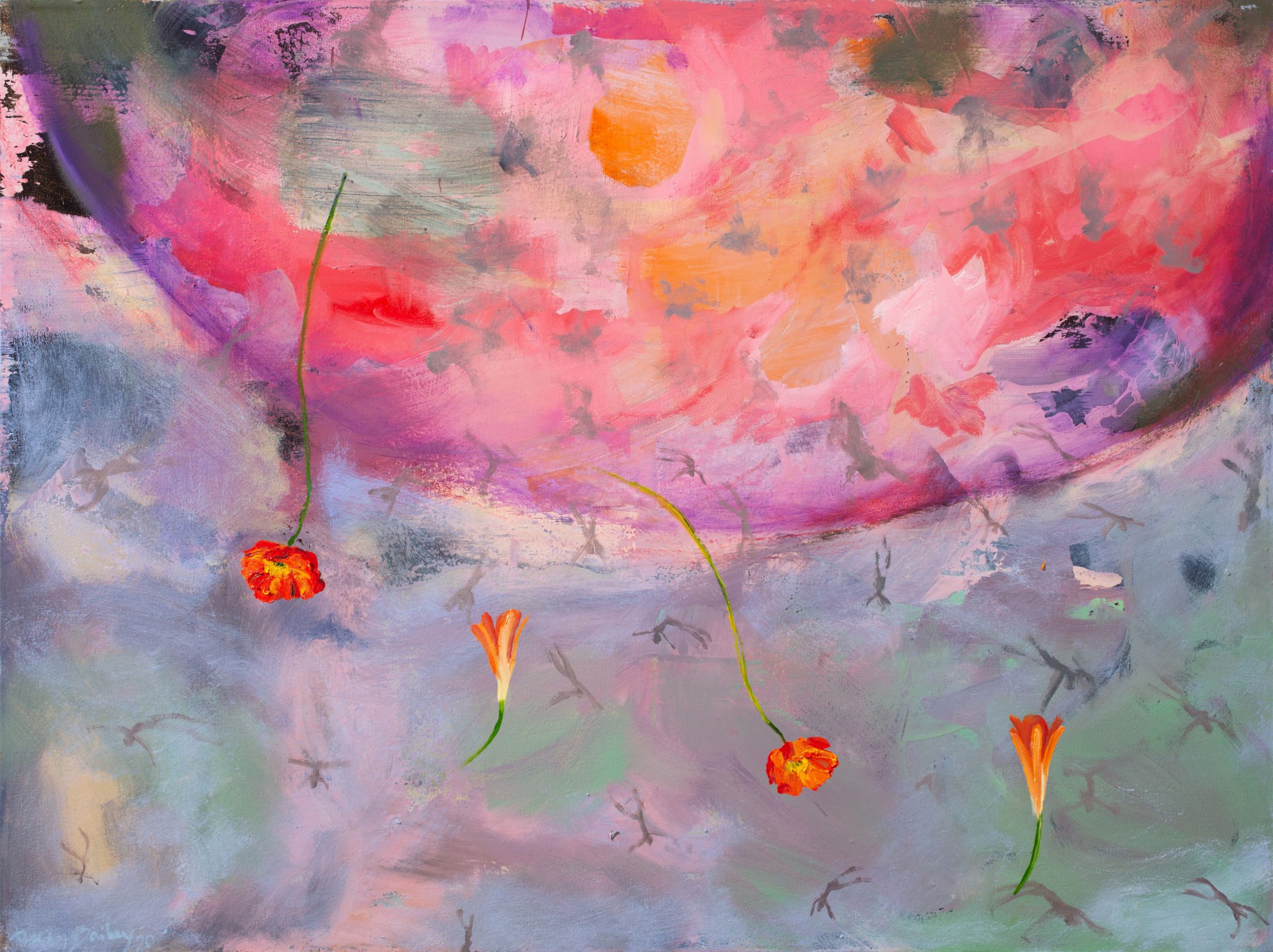
‘Falling off the world’ by Beezy Bailey (Image courtesy Everard Read CIRCA Gallery Cape Town and the artist)
By literally turning the world upside-down, Bailey alludes to the chaos of our present moment; the sweeping of “normal” (or balance?) from beneath our feet, so to speak.
“We’re in a serious crisis now,” he relates, “and it’s essential for artists to lead the way in offering us a way out. Offering something that allows us to love ourselves more.”
Hence the title of the exhibition: The Love Revolution, Bailey’s response to our desperate need to reach one another in a moment that is so fractured and distant.
Bailey knows as well as anyone that love is not “just hunky-dory schmaltzy lutzy”. Love – arguably the most polarising emotion of all – contains the ups and downs, ins and outs, depressions, elations, bona fide whirlwinds, (and more!) that are considered part of the human experience.
“Love is painful, love is intense, love is all-consuming. It’s a loaded thing. It comes with pain, it comes with heartbreak, it can be a double-edged sword”.
Love is also magical and glorious. It’s what makes us get out of bed in the morning, what makes us human. All the different kinds of love that we experience, and the different ways that we experience them, are a part of this beautiful, terrible thing we call life.
To live is to feel all of it. How could we ever feel happy if we never felt sad? Or experience love without the risk of heartbreak? There must be pain for there to be pleasure, evil for there to be good.
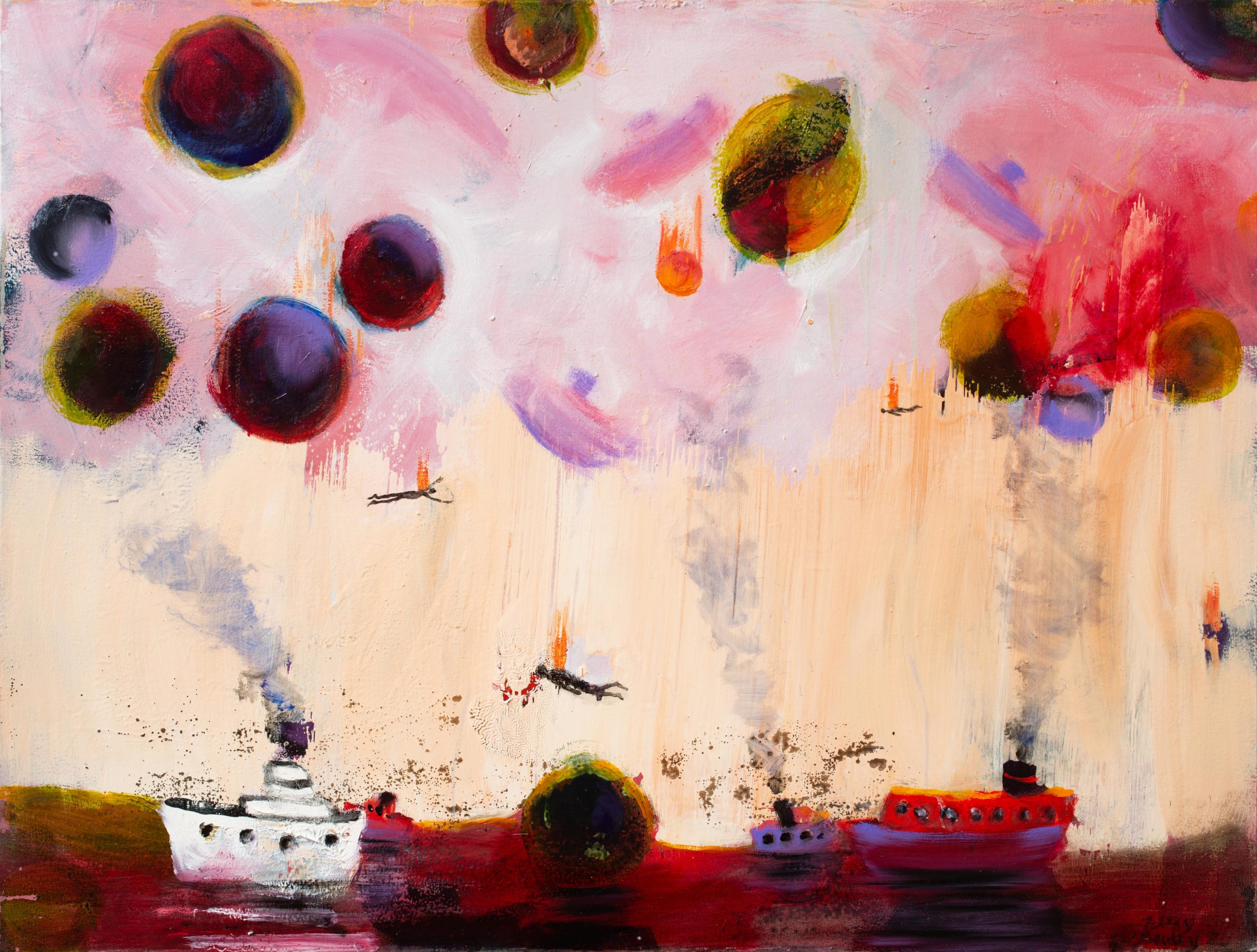
Friendly fire by Beezy Bailey; ‘The Love Revolution’ (Image courtesy Everard Read CIRCA Gallery Cape Town and the artist)
In The Love Revolution, Bailey reminds us that out of ugliness and pain comes beauty and meaning.
“I’ve been painting from a place of darkness and at the same time seeking the light. There is nothing like pain and suffering to make us artists sing so sweetly.”
Suffering is indeed the seed of some of the most important insights and artistic endeavours in human history. Bailey talks about the twisted art of Francis Bacon, a controversial English painter who was producing work before, during, and after World War Two. Bacon’s dark, distorted works are gruesome and disturbing; they reflect the communal trauma of the war, as well as his own abusive childhood in Ireland. His painting Three Studies for Figures at the Base of a Crucifixion, created in 1944 during the last few months of the war, received particular attention, becoming one of the most important pieces of modern art to date.
It is also a notably gory and disconcerting triptych, the mangled, grotesque figures in it scream and writhe against a bright red background in what looks like unbearable pain. It is one of Bacon’s best-known works, and also one of his darkest.
Interestingly, Bacon was supposedly the life and soul of the post-war parties. The bohemian revolution that swept London after WW2 was a period of light and prosperity, not an uncommon phenomenon, historically speaking, after a dark time of war or recession (here’s to hoping for the post-Covid roaring 2020s.) And Bacon was at the heart of it, creating his awfully gorgeous paintings that were so full of butchered life. He famously said: “I don’t believe in anything, not in God, not in morality, not in social success. I just believe in the present moment if it has genius.”
As Bailey points out, Bacon is a perfect illustration of the creativity that can come from destruction. It follows that the artists shared in their habit of destroying paintings that they did not think good enough. Bacon would shred his works to pieces with a box-cutter, while Bailey will “pour a whole tin of paint over it” if he doesn’t think a painting works.
“There is a huge connection between creativity and destruction. They are neck and neck, it’s the same emotion, the same thing.”
There is beauty in destruction, too. “My house burned down in Plettenberg Bay,” Bailey recounted, “and I was sent photographs of the house on fire. I just thought it was so beautiful.”
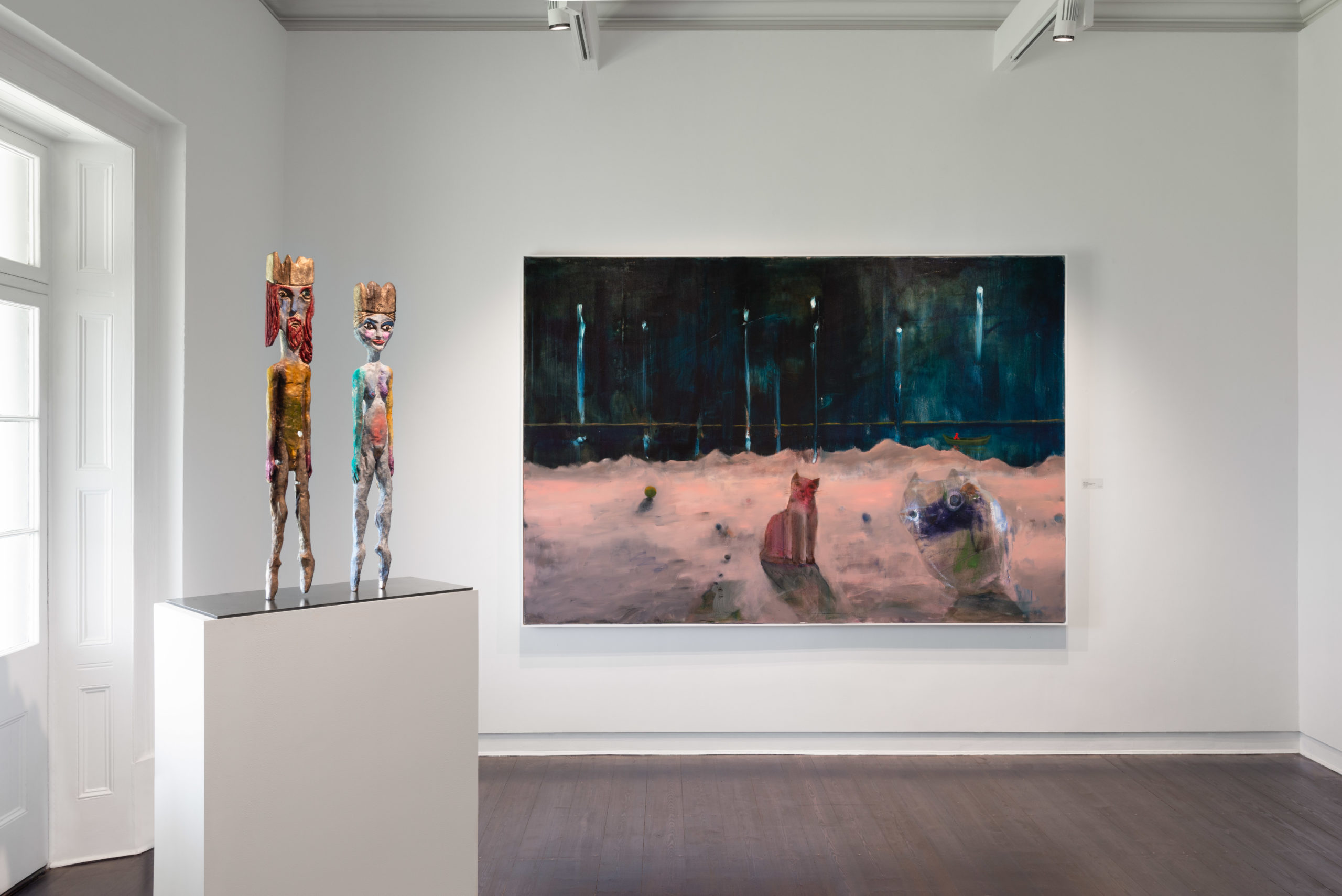
‘The Love Revolution’ installation (Photo by Michael Hall; courtesy Everard Read CIRCA Gallery Cape Town)
But there must always be balance. “We’ve lost touch with the creative side, so we only focus on the destructive side,” explained Bailey. It is the burden of an artist to channel this destruction into creativity, which is exactly what Bailey does. He views his art as a kind of “muti”(medicine), or balm, to soothe and heal the world.
In his creative process Bailey explains that he doesn’t “work with a preconcept. I only observe after I’ve painted what the hell is going on. A little bit like waking up and remembering a dream. You don’t plan the dream that you have, but then you try and dissect and understand afterwards.”
Bailey works in a state between the conscious and the subconscious, a feverish state where action comes before theory (another thing he has in common with the late, great Bacon).
Interestingly, the subconscious (or the unconscious, according to Freud), is defined in Britannica as “the complex of mental activities within an individual that proceed without his awareness”. Tapping into this part of his mind, Bailey channels thoughts, emotions, and images that have not yet been rationalised, sanitised, and cropped by his so-called rational mind. This means that the works he created for The Love Revolution often contain disturbing or dark imagery. “Generally, I’m not a dark, negative person. I suppose I’m simply reflecting the world that we’re living in.”
Dabbling with the unconscious mind brings to fore yet another duality that is often debated, especially when it comes to artists. That is to say, the shaky distinction between madness and genius. What is the very fine line that separates groundbreaking, risk-taking artists (geniuses), and those who simply cannot conform to societal norms, perhaps to their own detriment (the mad)?
Bailey looks at it like this: “What I have said in the past is that I am completely mad, I’m just clever enough to act sane.”
An outlook beautifully explored in two fantastical images featuring a homeless person (“bergie”) who lives in De Waal Park. Sporting an outfit made entirely of black bags, and known to locals as the Sunman because of his obsession with staring at the sun, this particular bergie caught Bailey’s eye due to his “angel-like” qualities. Local legend has it that the Sunman was once “a successful businessman for a very religious Muslim family, and now he’s schizophrenic and he won’t take his medicine. And that’s the life he’s chosen.”
Of the Sunman, Bailey says, “He has completely shed any connection to society as we know it. He will not take money, he’ll take food. He’s in a kind of moral, spiritual world. In a sense he’s superior to us, driving around in our Mercedes-Benzes, owing the bank money.”
Perhaps the Sunman understands life in a way that people who live safely within the boundaries of “normality” do not.
Bailey cuts in with an anecdote about Dave Matthews, the South African/American rock star with whom he collaborated on a few occasions: “We stopped on the side of the road and there was a musician begging, and Dave Matthews said that if things hadn’t turned out the way they did he would be that man. He would be begging on the side of the road. And he’s a multimillionaire rock star.”
One of the paintings, Sunman of the Stars, depicts the Sunman in a dark background, with stars shooting from his eyes. The second, Sunman in Eden, is set at daytime, the Sunman is surrounded by light and birds. The two paintings (dark and light), flank a ring of white-painted bronze sculptures that show a kneeling man, gazing towards the sky with hands clasped in prayer. Titled Refugee, the sculptures are “based on the refugee that arrives on the coast of Europe and prays… that iconic photograph. That’s him, that’s the refugee arriving and thinking everything is going to be okay now.” Something that we know, of course, isn’t always the case, given the way that many refugees and other diasporic identities are treated outside of their own countries.
The room is full of symbolic outsiders, bodies that have been excluded from society. The Sunman for being “mad” and the refugee for the colour of his skin or the nation he was born into. The bright, big, almost majestic shapes and colours that Bailey has rendered these bodies in gives them a holy or angelic tone. These are human bodies, even more than that they are angelic human bodies. We are forced to question why some bodies are allowed to be a part of “normal” society while others are excluded. Who decides who is an outsider? Why are some bodies considered more deserving than others?
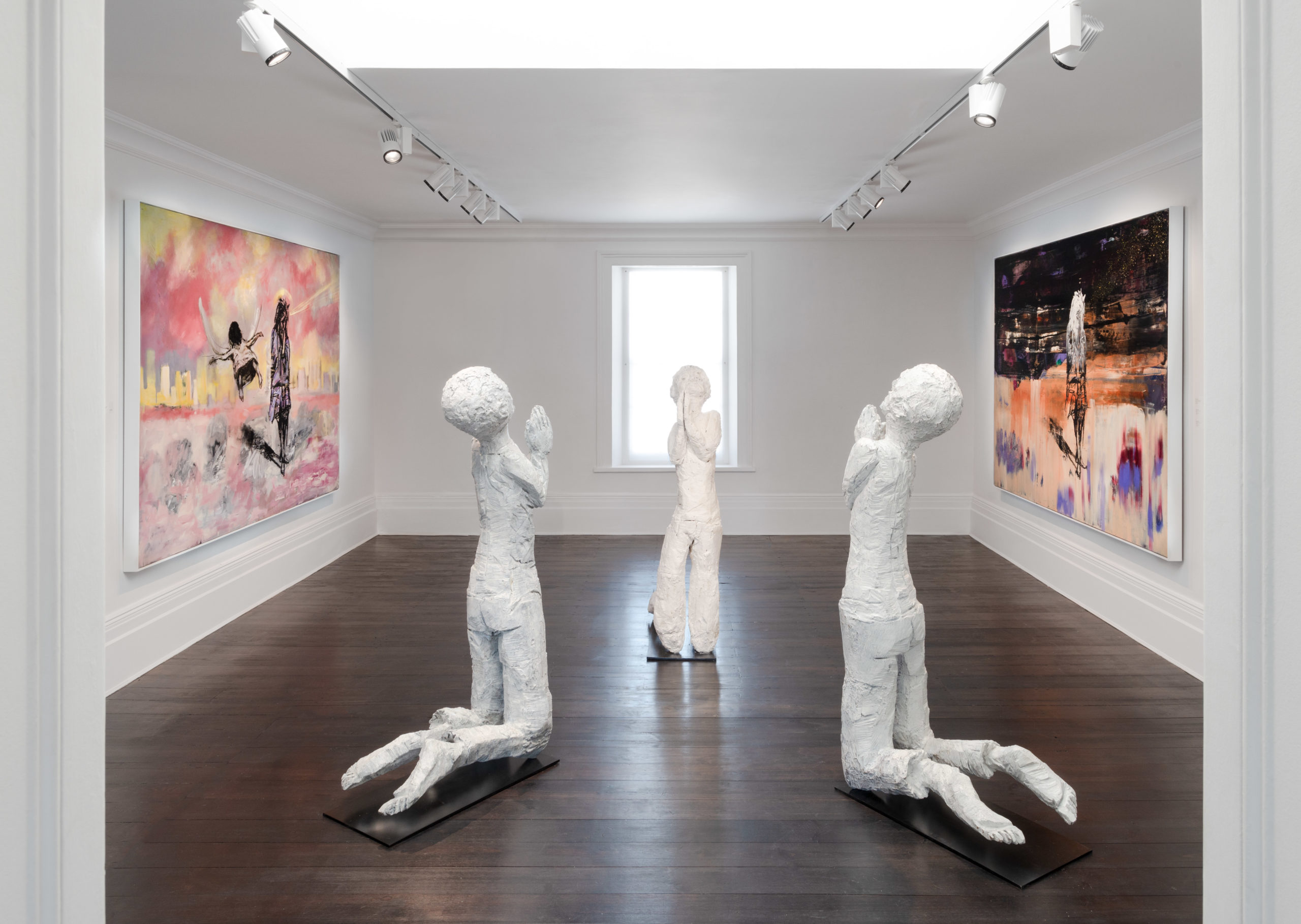
Refugee by Beezy Bailey in ‘The Love Revolution’ (Photo by Michael Hall; courtesy Everard Read CIRCA Gallery Cape Town)
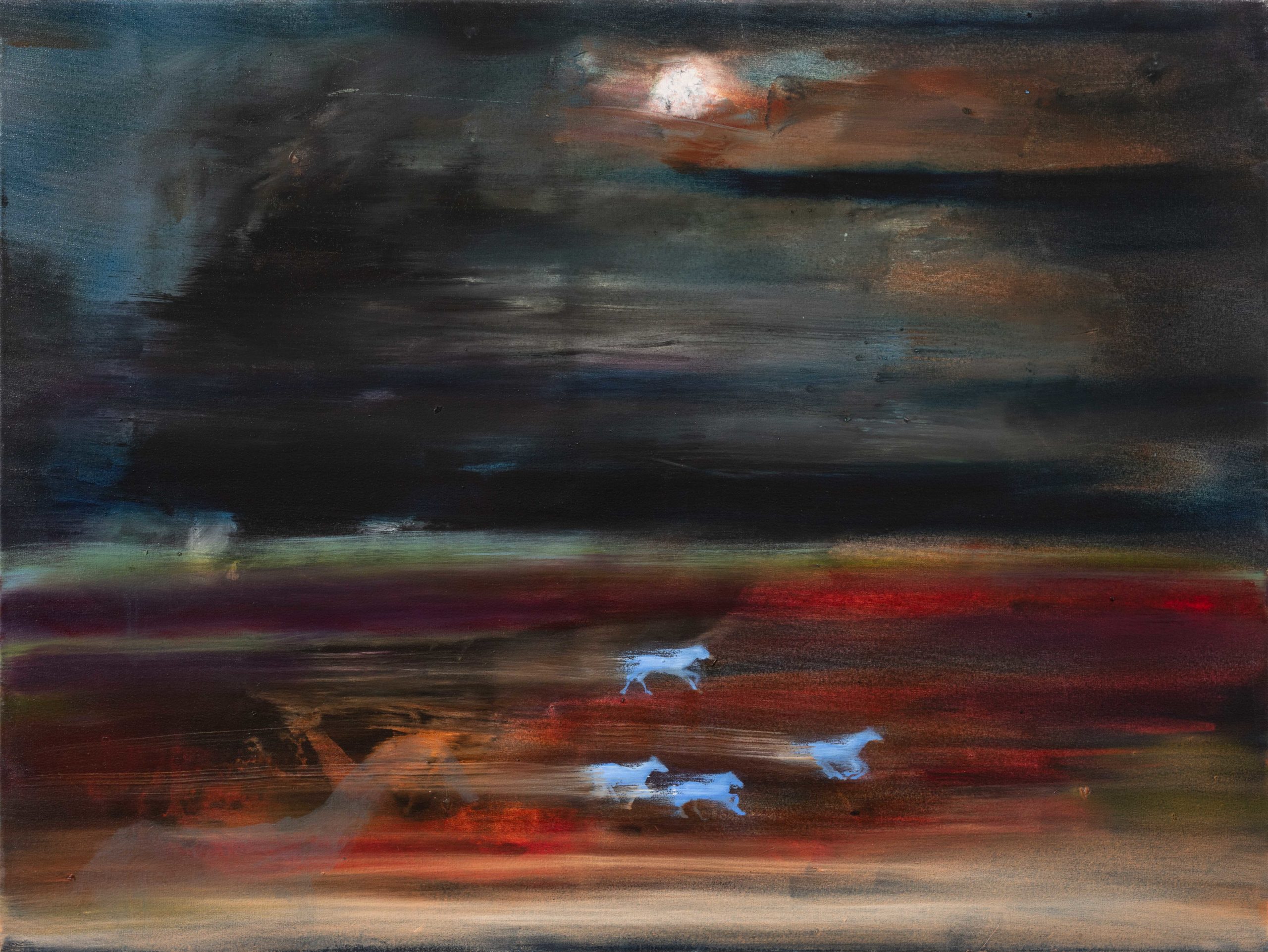
Racecourse on Jupiter by Beezy Bailey; ‘The Love Revolution’ (Image courtesy Everard Read CIRCA Gallery Cape Town and the artist)
An artist, continually attempting to make work that pushes against our preconceptions and assumptions, Bailey identifies with these outsiders. He’s also fascinated by them.
“He [Sunman] remains this elusive figure. Stu [Bailey’s assistant and collaborator] and I, we refer to him as a superstar. There was something equivalent to him as David Bowie or a really famous person, you couldn’t really get close to him.”
And Bailey knows quite a lot about famous people, having collaborated with (and been interviewed by) Bowie himself on several occasions. One of the most haunting pieces in The Love Revolution is a response to Bowie’s hit song The Man Who Sold the World. Bailey paints a desolate landscape full of dark corners and dilapidated skyscrapers. Shadowy figures linger in the peripheries, surrounding the only clear form in the painting, a forlorn looking man leaning alone against a tall building. He is the title of the painting, The Man Who Bought the World. A world that can be sold is also a world that can be bought.
“In a world of huge and tragic imbalance, this man leaning against his skyscraper is going, ‘What the hell have I done now? What is the world? What have I landed myself in? I’ve just bought it.’ It’s almost as if it were a tombstone, he’s burdened with this vast wealth and this power of owning the world.”
It’s the late-capitalist, fast-paced, money-crazy world that Bailey is railing against. A world that has been foiled, or at least slowed, by the pandemic, Bailey hopes.
“Before Covid we were heading for a brick wall at the speed of light. The speed of sound at least. We were just going too fast, and thoughtlessly. I think that [Covid] enables us to take track of what we’re doing to the environment, at least.”
Much of Bailey’s art contemplates the Anthropocene, defined as the most recent period in Earth’s history (the time that we are currently living through) during which human existence and activity has had a significant impact on the planet. Everything we do and have done as a species has changed the face of the planet.
Many of Bailey’s paintings feature “the migration of birds” – highly impacted by climate change, with results that we still do not fully understand – and imagery of the planet on fire or upside down.
“A lot of these paintings have to do with the idea that we’ve destroyed this planet, so we have to go to another planet that’s even more beautiful.”
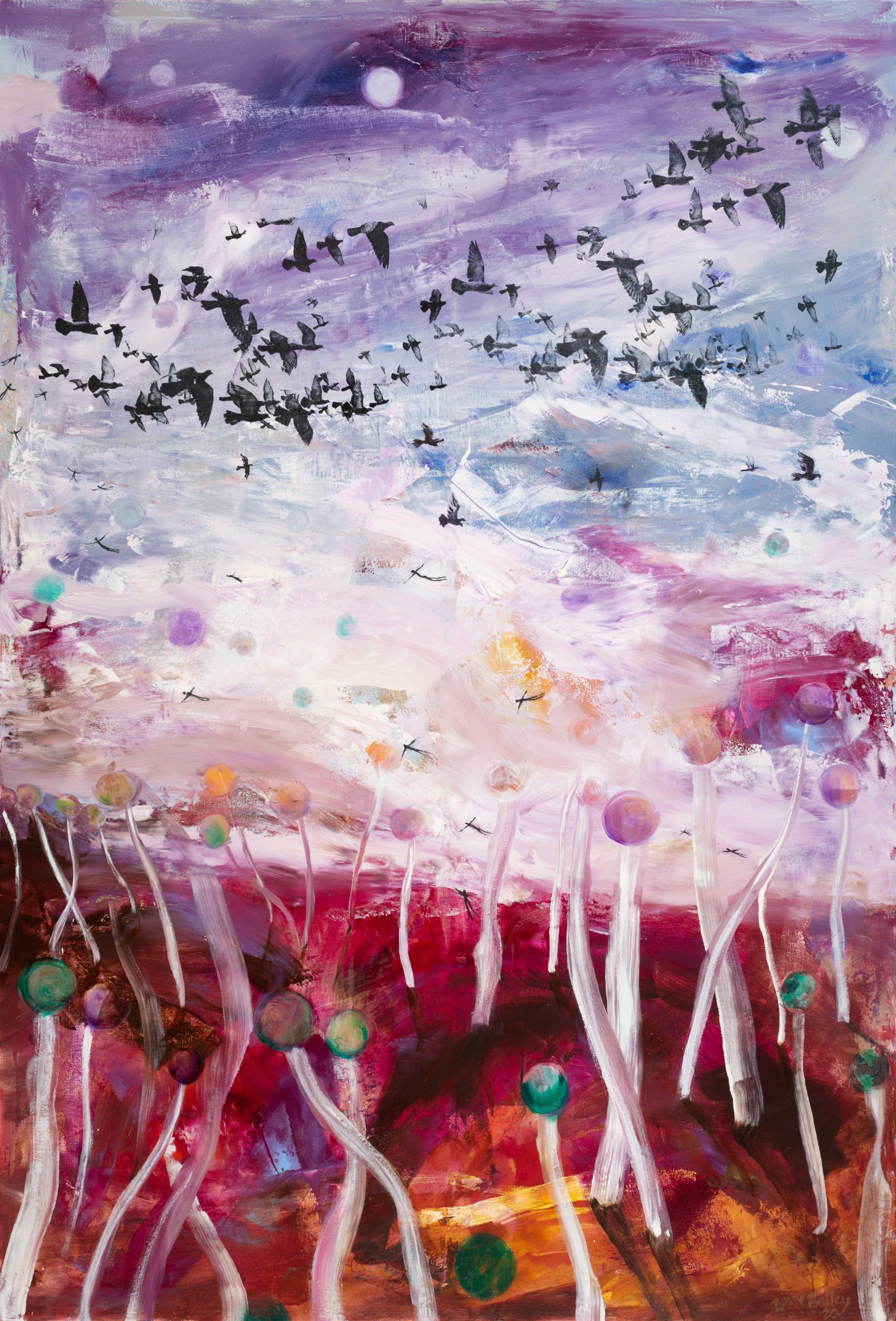
Birdman migration by Beezy Bailey; ‘The Love Revolution’ (Image courtesy Everard Read CIRCA Gallery Cape Town and the artist)
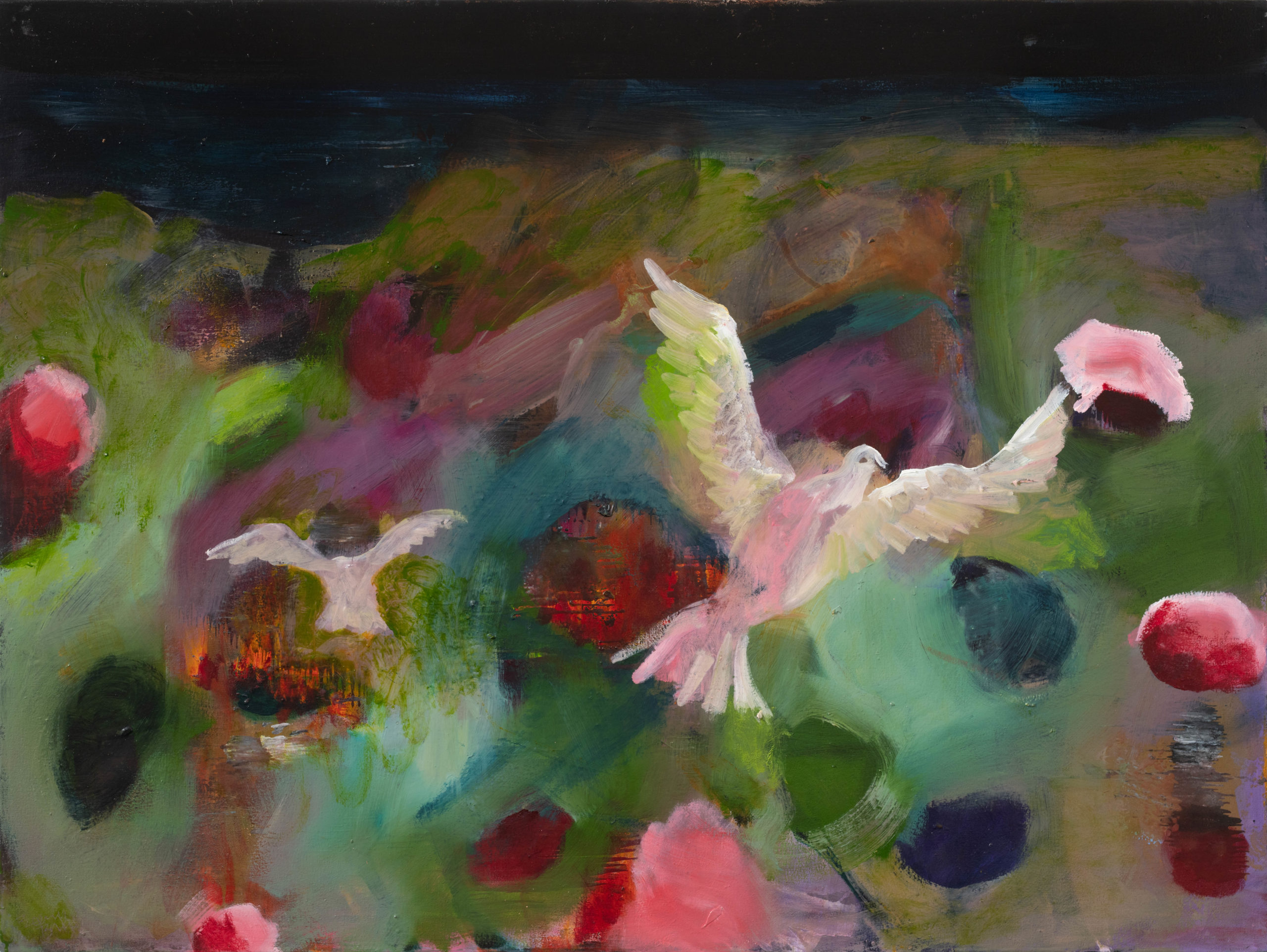
‘The magpies garden’ (Mixed media on canvas) in ‘The Love Revolution’ (Image courtesy Everard Read CIRCA Gallery Cape Town and the artist)
While the destruction of our planet is obviously heart-wrenching and overwhelming (especially when confronted with the scale of the damage we have already done), Bailey takes a somewhat positive outlook on things.
“I have this core belief that we reach a crescendo in all of this, where the very trees raise the skies on fire, and through that, we galvanise ourselves.”
Bailey believes there will be a resurrection (a theme that he has touched on before in the form of his Dancing Jesus work), not in the form of Christ as an individual but rather “a universal consciousness that emerges as a result of the catastrophe that we find ourselves in”. The destruction of the world as we know it could be a chance for renewal, a blank slate on which to start again.
As Bailey succinctly puts it, “The end of the world is the beginning of another.” There is hope for a new start if we believe it to be possible.
Bailey’s family history is an interesting parallel to this kind of thinking. The grandchild of Sir Abe Bailey, a significant Randlord and diamond tycoon, Beezy Bailey and his father (Jim Bailey, founder of Drum magazine, an important anti-apartheid publication) have certainly made hearty attempts at turning such a sordid history around.
“I, ultimately an optimist, believe that we’re finally coming to this place where out of this thing will be born a kind of paradise on Earth,” Bailey chimed, with hope. “A kind of consciousness, a universal love revolution. It’s a celebration of life, as we have it. Because life is so short, and it’s sacred, and we have it, and at last we are getting a chance to see that a little bit.”
The age-old pairing of life and death are present in Bailey’s paintings in the form of glowing spheres that Bailey calls “fallen angels” that pop up throughout the exhibition. To Bailey these are the energies of the once embodied, set free by death. They continue to make appearances in every part of Bailey’s painted world, floating in the sky, sinking into the earth, blossoming out of the soil as gorgeous circular flowers. To Bailey, the shards of energy that were once captured inside of our bodies become a part of the fabric of the Earth itself when we pass on. Death is as much a part of life as life itself.
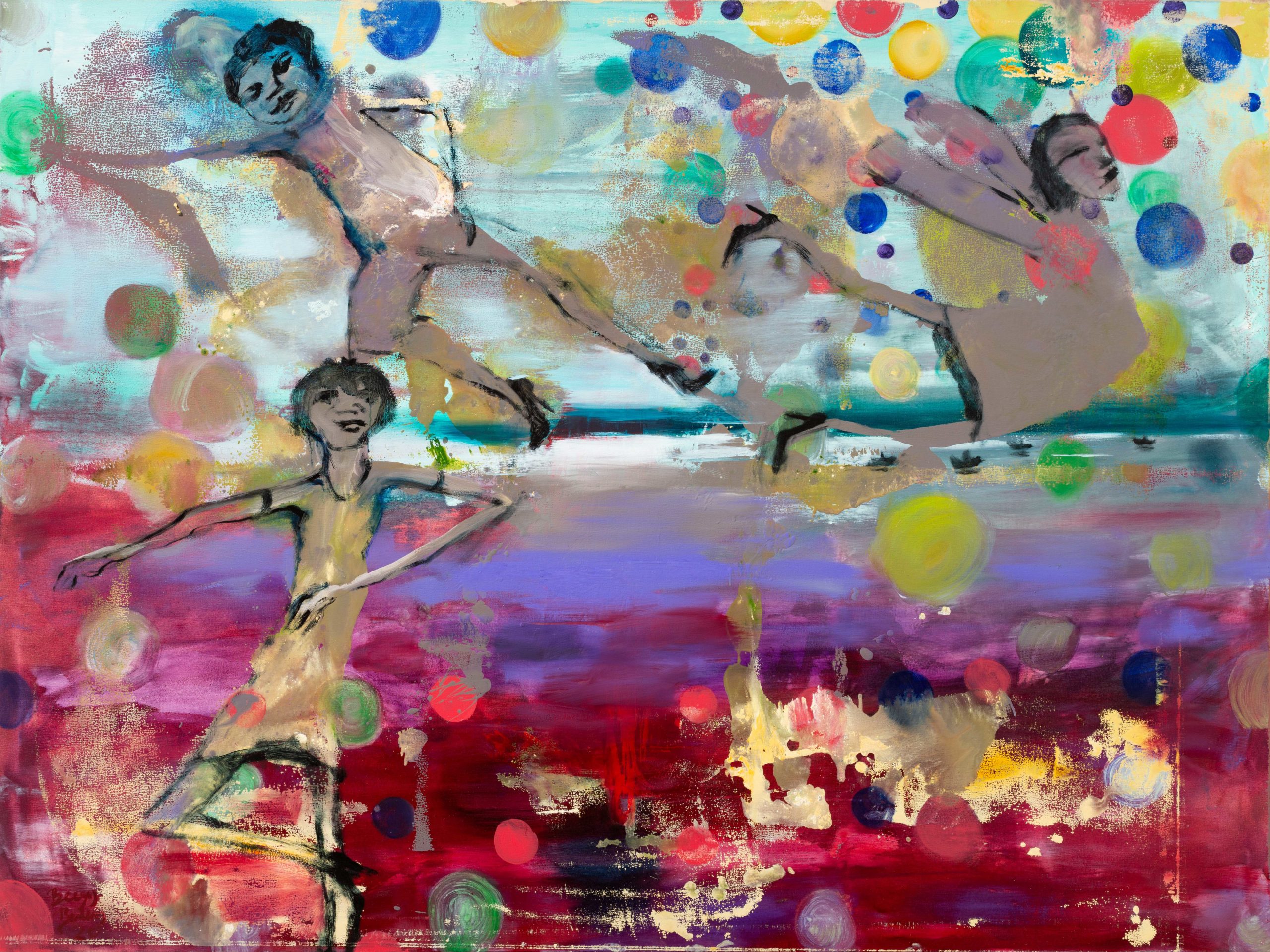
Beach party in Heaven by Beezy Bailey; ‘The Love Revolution’ (Image courtesy Everard Read CIRCA Gallery Cape Town and the artist)
“I lost a brother in a car crash many years ago when he was 20, and what it did do, what death does do, is teach me how to live every single day as if it were my last. I think, surrounded by all this death that’s happening, we have to acknowledge that every day is sacred.”
Ultimately, what Bailey is telling us is that the whole of life is important, not just the light/good/pleasure side of it. We need it all. The only thing that he warns against, the “greatest evil in the world”, is fear.
“Being afraid means that you are in a box, where a lot of people who control you and are horrible to you, want you to be.”
It’s also the reason we deprive ourselves of so much experience. If we fear the bad, we can never experience the good. Not to mention, to quote the infinite wisdom of Master Oogway, from the ever-profound cinematic genius of Kung Fu Panda: “One often meets their destiny on the path trying to avoid it.”
Bailey releases us from that fear; he reminds us of the fullness of life. Of the love, laughter, pleasure and joy that we can still experience, while showing us that there will be necessary (surmountable) potholes along the way.
“What’s happened now is that the world has been overwhelmed with darkness, and a lot of people can’t even see a little glimmer of light any more. As an artist I work with light, that’s my job. The paintings must throw out light.”
And this is how Bailey’s The Love Revolution works as “muti” and continues to offer us a little relief, a balm, a breath of fresh air. This is how he does his part for restoring the balance of the world. DM/ML
Beezy Bailey’s The Love Revolution is at the Everard Gallery CIRCA, 3 Portswood Rd, Waterfront, until 24 March 2021.


















 Become an Insider
Become an Insider
Comments - Please login in order to comment.